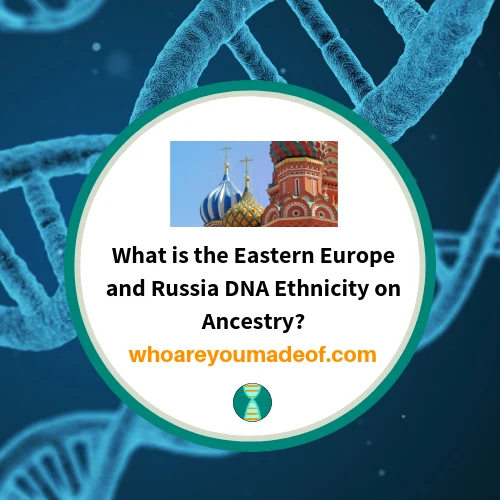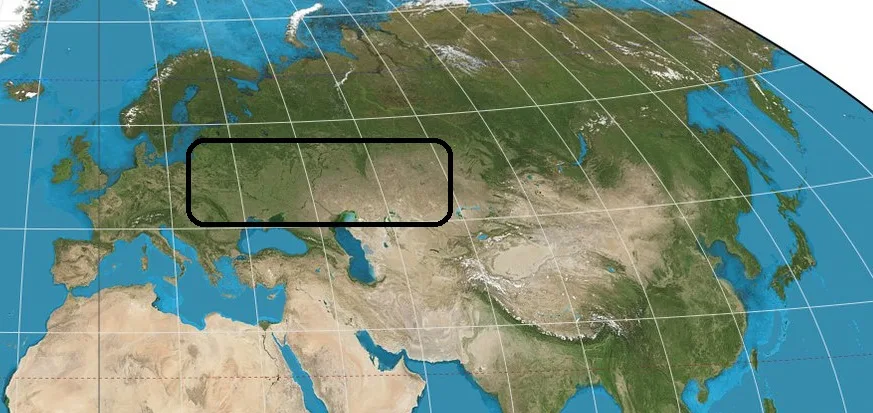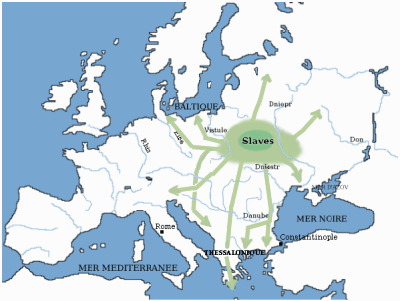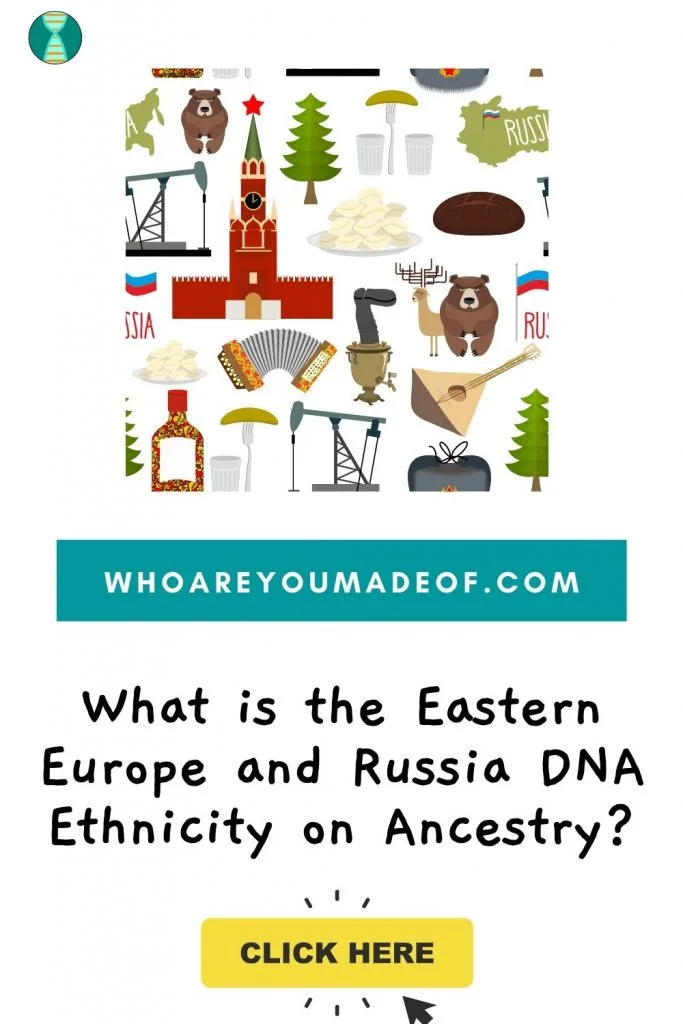Did you get the Eastern Europe and Russia DNA ethnicity in your ethnicity results? If you did, you are among almost 20 million Americans who can trace their ancestry back to Eastern Europe or Russia.
The Eastern Europe and Russia DNA region is a fascinating region made up of more than twenty countries and spanning more than 7,000 miles.

In this post, you'll learn:
- Where the Eastern Europe and Russia DNA ethnicity region is located
- Background about the genetic makeup of the region
- How to know which part of the Eastern Europe and Russia DNA region your ancestors were from
- How you may have inherited DNA from this region
- How to begin researching your Eastern European and Russian ancestors
Ancestry DNA did a major update of their ethnicity estimates this year, which you can read about in my post, "Ancestry DNA 2018 Ethnicity Estimate Update". People with ancestry in Eastern Europe and Russia might find that their ethnicity results no longer include the old Eastern Europe DNA region, and now includes this new, broader region.
Where is the Eastern Europe and Russia DNA Ethnicity region located?
The map below shows the approximate area of Europe and part of Asia where the Eastern Europe and Russia DNA ethnicity region is primarily found. It should be noted that the broader are where DNA from this region can be found extends all the way across Russia, an area much larger than is indicated in the black rectangle below:

By Strebe [CC BY-SA 3.0 ], from Wikimedia Commons
In which countries can you find Eastern Europe and Russia DNA?
As I mentioned previously, the Eastern Europe and Russia DNA region covers a very large portion of Europe and even Asia. The end result of this is that this ethnicity region can be found in people from many different countries where dozens of languages are spoken and striking cultural differences can be found.
The primary countries for this region are as follows:
- Poland
- Slovakia
- Czech Republic
- Austria
- Russia
- Hungary
- Slovenia
- Romania
- Serbia
- Ukraine
- Belarus
- Moldova
- Bosnia and Herzegovinia
- Croatia
Additionally, according to Ancestry DNA (and my own personal experience testing family members, you can also find Eastern Europe and Russia DNA in the following countries:
- Germany
- Montenegro
- Albania
- Kosovo
- Macedonia
- Bulgaria
- Kazakhstan
Is there Eastern Europe and Russia DNA in other parts of Europe?
If your ancestors didn't come from any of the countries listed on the list above, you might be worried that your DNA results are wrong, or that your family tree is wrong. More likely, you are both right.
Your ancestors may have indeed come from France or Germany, or any other number of European countries, but their ancestors may have had Eastern European or Russian ancestors. Europe has been a place of great migration for centuries.
Wars and political and religious persecution, as well as dire economic situations, have always driven people from their homelands. While some people were able to cross the Atlantic to go to North or South America, others found it easier to make new lives in foreign European nations.
Additionally, it's very common for people in one DNA region to show DNA from a neighboring region. For example, people from certain parts of the Germanic Europe DNA region would likely show Eastern Europe and Russia DNA.
People from Eastern Europe and Russia might show DNA from the Baltic States or even Scandinavian countries. Even people in England, which generally falls under the England, Wales, and Northwestern Europe DNA region might find themselves with Eastern European or Russian ancestry, as people have been migrating from Eastern Europe to the British Isles for many generations.
So What is Eastern European and Russian DNA?
From a modern DNA perspective, the earliest groups of people to inhabit the Eastern Europe and Russia DNA region are the Slavs. In fact, they are considered to be native to the region - the original modern human inhabitants.
The Slavs shared a common linguistic and cultural history, which is still visible today. People throughout Eastern Europe and Russia speak Slavic languages and have Slavic customs.
The map below shows how the Slavic peoples, generally referred to as tribes, spread throughout Eastern Europe and Russia between the years 500-1000. They were held in the Eastern Europe by the early Roman Empire and formidable Germanic tribes that dominated Western Europe.
Later, the powerful Mongols prevented further expansion to the east.

By User Fphilibert from fr.wiki [GFDL (http://www.gnu.org/copyleft/fdl.html) or CC-BY-SA-3.0, via Wikimedia Commons
Even though the Slavs were the original inhabitants of the region, the genetic makeup of the Eastern Europe and Russia DNA region was influenced by the Roman Empire, the Huns (a Turkic people), the Alans (Iranian), the Mongols (from Mongolia), and the Ottoman Empire, among other groups.
Furthermore, more recent history, beginning around 1500, saw shifting political boundaries, wars, and mass migrations between varying regions of this larger DNA area.
How do I know which part of Eastern Europe and Russia my ancestors were from?
Some of us already know, or are pretty sure, from where our ancestors came in Eastern Europe and Russia. Maybe we grew up eating particular foods, or our grandparents understood Slovak or Russian, or we used to visit our ancestor's home country of Poland during wonderful summer vacations when we were kids.
For various reasons, others among us weren't lucky enough to grow up knowing about our Eastern European or Russian heritage.
There are two basic ways that you can begin to learn where your ancestors lived in the Eastern Europe and Russia DNA region:
- Building a family tree
- Possibly being assigned a sub-region on Ancestry DNA (read more below)
The best way to know where your ancestors lived in Eastern Europe or Russia?
If you don't know much about your ancestry, it might seem overwhelming to try to build a family tree in search of your Eastern European ancestors. While it can take some time and patience, it's easier than you might think to track down where your ancestors were born.
I always recommend that people tracing their Eastern European or Russian roots start with their parents. Talk to your parents, and ask them what they know about their parents and grandparents.
Ask them if they knew where they went to church, what religion they were, what languages they spoke, and even what their favorite foods were growing up.
All of these seemingly unimportant details can help point you in the right direction.
Of course, if your grandparents or great-grandparents are still living, then definitely talk to them! They are living history books, and are almost always glad to talk about their lives.
Many times, our older family members are happy that the younger generations are interested in family history.
Once you've talk to all of your living family members, it's time to put everything that you learned into a family tree. I recommend using Ancestry for family tree building, especially if you did a DNA test with Ancestry, but even if you didn't.
(Read my post about how to build a family tree on Ancestry to find out how to do it)
After you've learned the names of your parents, grandparents, and great-grandparents, you can begin to search for their passenger records, immigration documents, birth and death records, marriage records, and church documents that can help you narrow down the location of their home country within Eastern Europe or Russia, and possibly even their home town.
Eastern Europe and Russia sub-regions on Ancestry DNA
The Eastern Europe and Russia DNA region on Ancestry is currently divided into fourteen sub-regions:
- Czech Republic, Slovakia, Poland & Lithuania (contained seven smaller sub-regions)
- Northeast Italy, Croatia & Bosnia and Herzegovina
- Poland, Slovakia, Hungary & Romania (contains four smaller sub-regions)
If you didn't get assigned to a sub-region, don't worry! This doesn't mean that you don't really have ancestors from this region.
Some people are fortunate and get a region, and it usually means relatively recent ancestry from an area covered by a particular sub-region.
Sometimes, even though you do have recent ancestry from a place covered by a sub-region, the Ancestry DNA algorithm still doesn't assign a sub-region. The most common explanation for this?
- Your ancestors are from the region, but they may have had ancestry from neighboring areas
- Since we inherit DNA in a random fashion and don't inherit all of our parent's DNA, you might not share as much DNA with those ancestors as you do some of your other ancestors
How did I get Eastern Europe and Russia in my DNA Results?
By now, you might have already figured out that you have Eastern Europe and Russia DNA in your results because you probably have an ancestor from the region. The next question that people generally ask is "how far back is my ancestor"?
This question can be harder to answer, especially if your ancestry is very distant. If you have a very small percentage of DNA from this region, you might have a few very distant ancestors who contributed it, or just one ancestor several generations back who was "100%" from Eastern Europe or Russia.
Even if you have a higher percentage (more than) 10% Eastern Europe and Russia on your ethnicity results, it doesn't necessarily mean that your "100% ancestor" was only a couple generations back.
For example, I have more than 20%, and this because both of my parents have ancestry from Slovakia, Poland, or Germany. Furthermore, my mother has it on two lines of her family.
In other words, I have inherited some Eastern European and Russian DNA from both of my parents, and from more than one line on my mom's side.
So, how do you know how your Eastern Europe and Russian DNA got into your results? Get started on that family tree 😉

Conclusion
I hope that this post has given you some insight into your Eastern Europe and Russian DNA, how you may have inherited your DNA from this region, and how to go about researching your ancestors.
If you have any questions about something that you read in this post, or would like to share your experience learning about your DNA from this area, I would love to hear from you in the discussion below.
Thanks for stopping by!

BTP
Sunday 20th of October 2024
My maternal grandparents and great-grandparents were relatively recent immigrants, coming from Ukraine and Slovakia. At the time, both were part of the Austro-Hungarian empire. My latest DNA results show 49 percent central and eastern Europe. My ethnicity report was accurate in that respect. Since the results match information I know to be true, that gives me some confidence in the results.
Rachel Rakaczky
Friday 20th of October 2023
I just got my updated Ancestry DNA results which reflect an 18% Eastern Europe & Russia ancestry. I happen to know that my father's father's father (my paternal great grandfather) was born in Abaujlak, Borsod-Abauj-Zemplen, Hungary in 1887 (my father and his father were both born in Connecticut). As far as I know, I have no other relatives from this giant region. But I was only able to trace my paternal line so far (without actually going to Italy or Hungary and searching their records). My mother's line, on the other hand, is almost 50/50 English/Scottish, and I've traced it back to 1101 with my 26th great grandfather (whose name is actually Norman, but I'm not really sure how that figures into things, DNA wise). Gotta love those English record keepers.
M A Shaw
Friday 12th of August 2022
My 23andme DNA test results show 1.4% eastern european ancestry, 0.9% Italian I am 92.2% sub saharan african (primarily from ghana) my great grandfather was from England (grandmother mixed race) The eastern european results came as a bit of shock tbh but a wonderful surprise. 23andme are unable to give me a specific region where my Eastern European ancestor came from and then I read this article
https://www.ancestry.com/corporate/international/press-releases/DNA-of-the-nation-revealedand-were-not-as-British-as-we-think
hey
Sunday 12th of June 2022
The second image, the diagram with the Slavic population movement, has a big typo.
moldynorwesterner
Sunday 22nd of January 2023
@hey, this is from a French site, and the French word for "Slavs" is "Slaves." All the other spellings on that map are in French, also. Not sure if this is what you are referring to, but this may explain your comment??
Karen Eileen Marx
Friday 25th of February 2022
I have 48percent Percent Eastern Europe and Russia and 26 percent Germanic Europe, I know my Grandpa was German, My dad parents were from the Urcane.